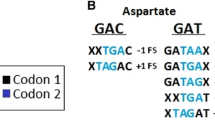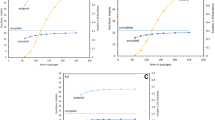Summary
The proposal by Schultz and Yarus is that changes in the genetic code result from ambiguous reading of codons. This is a simplistic catchall scheme. Our codon capture hypothesis was accompanied by case studies of each incident; for example, AAA changing to asparagine from lysine was preceded by all AAA lysine codons mutating to AAG under GC pressure, with disappearance of lysine anticodon UUU, followed by appearance of a new anticodon IUU for asparagine which would wobble-pair with AAU, AAC, and AAA (Ohama et al. 1990a). Ambiguous coding would not confine itself to changes in the genetic code to accommodate the proposal by Schultz and Yarus, but would extend throughout the genome if their idea is correct. Under these circumstances, much impairment of the accuracy in codon reading that is needed for maintenance of the constant sequences of amino acids in proteins would occur. Surely the net effect would be deleterious. Our conclusion is that the proposal by Schultz and Yarus is a “simple and easy answer to a complex and difficult problem,” and is not acceptable.
Similar content being viewed by others
References
Böck A et al. (1991) Selenocysteine the 21st amino acid. Mol Microbiol 5:515–520
Inagaki Y et al. (1993) Lack of peptide-releasing activity responding to codon UGA in Mycoplasma capricolum. Nucleic Acids Res 21:1335–1338
Jukes TH et al. (1987) Divergence and directional mutation pressure. Nature 325:668
Jukes TH, Osawa S (1996) CUG codons in Candida spp. J Mol Evol 42:321–322
Kano A et al. (1991) Novel anticodon composition of transfer RNAs in Micrococcus luteus, a bacterium with a high genomic G + C content. Correlation with codon usage. J Mol Biol 221:387–401
Oba T et al. (1991) CGG, an unassigned or nonsense codon in Mycoplasma capricolum. Proc Natl Acad Sci USA 88:921–925
Ohama T et al. (1990a) Evolution of the genetic code IV. AAA as an asparagine codon in some animal mitochondria. J Mol Evol 30:329–332
Ohama T et al. (1990b) Role of GC-biased mutation pressure on synonymous codon choice in Micrococcus luteus, a bacterium with a high genomic GC-content. Nucleic Acids Res 18:1565–1569
Ohama T et al. (1993) Non-universal decoding of the leucine codon CUG in several Candida species. Nucleic Acids Res 21:4039–4045
Osawa S (1995) Evolution of the genetic code. Oxford University Press, Oxford, 204 pp
Osawa S, Jukes TH (1989) Codon reassignment (codon capture) in evolution. J Mol Evol 28:271–278
Osawa S, Jukes TH (1995) On codon reassignment. J Mol Evol 41:247–249
Osawa S et al. (1992) Recent evidence for evolution of the genetic code. Microbiol Rev 56:229–264
Schultz DW, Yarus M (1994) Transfer RNA mutation and the malleability of the genetic code. J Mol Biol 235:1377–1380
Schultz DW, Yarus M (1996) On malleability in the genetic code. J Mol Evol 42:597–601
Tourancheau AB et al. (1995) Genetic code deviations in the ciliates: evidence for multiple and independent events. EMBO J 14:3262–3267
Yamao F et al. (1991) Levels of tRNA in bacterial cells as affected by amino acid usage in proteins. Nucleic Acids Res 19:6119–6122
Yokogawa T et al. (1992) Serine tRNA for translation of non-universal codon CUG in Candida cylindracea: Evolutionary implications. Proc Natl Acad Sci USA 89:7408–7411
Author information
Authors and Affiliations
Rights and permissions
About this article
Cite this article
Jukes, T.H., Osawa, S. Point counter point. J Mol Evol 45, 1–3 (1997). https://doi.org/10.1007/PL00006192
Issue Date:
DOI: https://doi.org/10.1007/PL00006192




